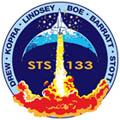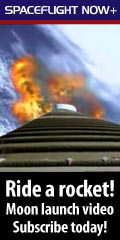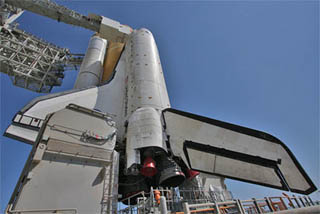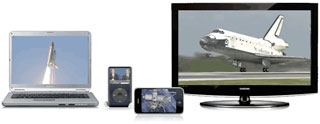 Orbiter: Discovery Mission: STS-133 Payload: Leonardo Launch: Feb. 24, 2011 Time: 4:53 p.m. EST Site: Pad 39A, Kennedy Space Center Landing: March 9 @ approx. 11:57 a.m. Site: KSC's Shuttle Landing Facility  
|
Mission Status Center
Welcome to Spaceflight Now's live coverage of space shuttle Discovery's STS-133 mission to the International Space Station. Text updates will appear automatically; there is no need to reload the page. MONDAY, MARCH 7, 2011
Space shuttle Discovery's 50-foot-long robotic arm has been cradled back into the payload bay and powered down, completing the orbiter's final use of its Canadian-built arm.
2151 GMT (4:51 p.m. EST) 2114 GMT (4:14 p.m. EST)
The Orbiter Boom Sensor System has been berthed in the payload bay, its job complete for the mission. Analysts on the ground will be examining all of the imagery gathered and should have the heat shield cleared of any concern tomorrow.
2039 GMT (3:39 p.m. EST)
The heat shield surveys have been completed for Discovery's mission. The crew will be putting the inspection boom in its cradle in the payload bay shortly.
1920 GMT (2:20 p.m. EST)
Observations of the port wing are now underway aboard shuttle Discovery by commander Steve Lindsey, pilot Eric Boe and mission specialist Al Drew. This is the third and final part of the inspections for today.
1904 GMT (2:04 p.m. EST)
Discovery's reinforced carbon-carbon nose cap has been surveyed as the astronauts use the Orbiter Boom Sensor System on the end of the shuttle's robot arm for a series of heat shield inspections. The scans are similar to the ones performed the day after launch. Today's survey results will be compared with the earlier data to ensure the orbiter's wing leading edge panels and nose cap are free of any space debris impacts that could have happened during the mission.
1840 GMT (1:40 p.m. EST)
Check out Spaceflight Now's Facebook page!
1805 GMT (1:05 p.m. EST)
The right wing has been scanned using the laser and camera package of the Orbiter Boom Sensor System. The crew is swinging the boom in position to inspect Discovery's nose cap next.
1654 GMT (11:54 a.m. EST)
The starboard wing surveys are getting started.
1615 GMT (11:15 a.m. EST)
The crew has the inspection boom in motion for today's heat shield inspections.
1337 GMT (8:37 a.m. EST)
The shuttle is quickly departing the vicinity of the space station following separation burn No. 2 producing a 3 feet per second change in velocity.
The astronauts will spend the rest of their workday using the Orbiter Boom Sensor System to inspect the shuttle's wing leading edge panels and nose cap to look for any space debris or micrometeoroid damage that could have occurred during the mission. Standard day-before-landing tests of Discovery's flight controls and thrusters, along with packing up the cabin for entry will fill the crew's Tuesday in orbit. Landing at the Kennedy Space Center to conclude this spaceflight is scheduled for Wednesday at 11:57 a.m. EST. A backup landing opportunity is available an orbit later at 1:34 p.m. EST. The early weather forecast for the Kennedy Space Center calls for acceptable conditions at the landing site. The outlook includes scattered clouds at 3,000 and 20,000 feet, seven miles of visibility, southeasterly winds from 120 degrees of 15 peaking to 21 knots. 1336 GMT (8:36 a.m. EST)
Discovery is 7,600 feet from the station, separating at 6 feet per second.
1332 GMT (8:32 a.m. EST)
Over 6,000 feet away now, opening at 6.15 feet per second.
1327 GMT (8:27 a.m. EST)
Now 4,300 feet between the two spacecraft, separating at 5.69 feet per second.
1320 GMT (8:20 a.m. EST)
Discovery is climbing high above and behind the station. Now 2,100 feet away, separating at 4 feet per second.
1317 GMT (8:17 a.m. EST)
The shuttle is 1,400 feet from the station and about 20 minutes away from the next engine burn.
1309 GMT (8:09 a.m. EST)
The shuttle just performed the first of two separation engine firings. This brief burn changed Discovery's speed by about 1.5 feet per second.
1308 GMT (8:08 a.m. EST)
The space shuttle Discovery is out in front of the International Space Station to complete its full victory lap.
1304 GMT (8:04 a.m. EST)
Discovery is passing over Italy now as the shuttle continues the station flyaround.
1256 GMT (7:56 a.m. EST)
The shuttle is beneath the station now, continuing its circle around the complex, as the spacecraft fly over the Atlantic and near the coast of Africa.
1252 GMT (7:52 a.m. EST)
In a pre-flight interview, pilot Eric Boe talked about this task of flying Discovery around the space station:
"Well, it's always neat. I've only done it one other time for myself on my last mission to actually fly around and look at the station so just getting the opportunity to do it at all is truly amazing and the fact that it may be one of the last times that a shuttle gets to go, it's an honor to get the opportunity to do it and I will be appreciating every second, watching it and really just trying to put it in my memory, just like when you're on a vacation and you're watching something that's really neat or going to some other type of event. I will try to record all that in my memory banks so that I can play it back for years to come." 1247 GMT (7:47 a.m. EST)
The shuttle is reaching a point directly behind the station in terms of the direction of travel of the two spacecraft around the Earth, which is known as the -V bar.
1243 GMT (7:43 a.m. EST)
The shuttle is descending in its loop around the station. Now about 725 feet away.
1235 GMT (7:35 a.m. EST)
Discovery is reaching a point about 600 feet directly above the space station.
The flyaround started with the shuttle in front of the station. It takes Discovery to a point directly above the complex, then behind it, looping below and back out in front. After climbing above the station for a second time, the final separation engine firing will be performed. This burn will send Discovery away from the vicinity of the station. 1231 GMT (7:31 a.m. EST)
Distance between the two craft has grown to 505 feet.
1224 GMT (7:24 a.m. EST)
The spacecraft are passing into an orbital sunrise over the South Pacific.
1223 GMT (7:23 a.m. EST)
Pilot Eric Boe has begun flying Discovery in a one-lap flyaround of the station.
1222 GMT (7:22 a.m. EST)
The shuttle is headed to a point more than 400 feet away where it will fire thrusters to begin an arc above the station for today's flyaround.
1221 GMT (7:21 a.m. EST)
Now 375 feet of separation.
1216 GMT (7:16 a.m. EST)
Discovery is 236 feet from the station, continuing to separate at 0.27 feet per second.
1208 GMT (7:08 a.m. EST)
Passing the 100-foot mark.
1205 GMT (7:05 a.m. EST)
Now 50 feet of separation with Discovery moving away at 0.3 feet per second.
1204 GMT (7:04 a.m. EST)
"Discovery departing," International Space Station commander Scott Kelly says as he rings the station's bell.
1202 GMT (7:02 a.m. EST)
Discovery is 20 feet from the station as it slowly backs away.
1201 GMT (7:01 a.m. EST)
The undocking occurred as the two spacecraft flew 220 miles over the Pacific Ocean, east of Indonesia and northeast of Australia.
1200 GMT (7:00 a.m. EST)
UNDOCKING! Discovery and the International Space Station are parting company after 8 days, 16 hours and 46 minutes of being linked together high above Earth. The successful visit by the space shuttle delivered and opened the Permanent Multipurpose Module, literally a roomy float-in closet for storage, and installed another outdoor spare parts pallet.
Discovery is due home at the Kennedy Space Center on Wednesday, weather permitting, to complete her 39th and final flight. 1159 GMT (6:59 a.m. EST)
Hooks and latches are driving open.
1155 GMT (6:55 a.m. EST)
Five minutes from undocking. The steering jets on Discovery are inhibited for the period of physical undocking from the station. The separation occurs when large springs push the two craft apart. Once the shuttle is a couple feet away from the station and the docking devices are clear of one another, pilot Eric Boe will fire Discovery's thrusters to continue the movement away.
1150 GMT (6:50 a.m. EST)
The spacecraft have passed into an orbital sunset. The undocking will occur in darkness but the later flyaround of the station by Discovery will take place in daylight.
1145 GMT (6:45 a.m. EST)
"Houston is go for undocking," CAPCOM Steve Robinson just radioed the astronauts.
1140 GMT (6:40 a.m. EST)
Both the shuttle and station flight control teams report all systems are ready for the undocking at 7:00 a.m. EST. Discovery's guidance system was aligned this morning, the station's giant solar arrays have been positioned to protect them from shuttle thruster plumes and the entire shuttle/station complex was reoriented to the proper attitude for undocking.
1100 GMT (6:00 a.m. EST)
Throughout the time Discovery has been docked to the space station, the combined stack flew in an orientation with the Russian segment leading the way. This was meant to keep Discovery's heat shield out of the direction of travel. But as undocking approaches, the stack is being turned 180 degrees to enable Discovery to separate and fly out in front of the station, reversing its path to docking nearly 9 days ago.
0945 GMT (5:45 a.m. EST)
The latest version of the NASA Television schedule (Rev. K) can be downloaded here.
0930 GMT (5:30 a.m. EST)
The crew of the shuttle Discovery, awakened by actor William Shatner reading a "Star Trek" tribute marking the veteran spaceplane's final voyage, geared up to undock from the International Space Station today to close out an extended assembly and resupply mission, the shuttle's 13th and last visit.
Read our full story. 0900 GMT (4:00 a.m. EST)
A humanoid robot delivered to the space station by the shuttle Discovery should come out of its packing crate by the end of March, and ground crews could start tinkering with the Robonaut soon after. But it could be months before NASA trusts the robot to help astronauts do chores on the complex.
Read our full story. 0830 GMT (3:30 a.m. EST)
With a special musical tribute, the space shuttle Discovery astronauts have been awakened for undocking day. The orbiter will separate from the International Space Station at 7:00 a.m. EST, then begin a one-lap flyaround of the outpost.
Playing the Star Trek theme song with William Shatner narrating: "Space... the final frontier. These have been the voyages of the space shuttle Discovery. Her 30-year mission: to seek out new science, to build new outposts, to bring nations together on the final frontier, to boldly go and do what no spacecraft has done before." "And good morning, Houston," Lindsey replied when the music faded. "And that was, I believe, the second most popular selection from the song contest for the space shuttle program and I'd like to thank William Shatner for taking the time to record that special introduction for us." SUNDAY, MARCH 6, 2011
After transferring a final few items to and from the International Space Station -- and enjoying a bit of zero-gravity fun in a roomy new storage module -- the Discovery astronauts bid their station colleagues farewell Sunday, floating back aboard the orbiter to rig the ship for undocking early Monday to wrap up this shuttle's final visit.
2155 GMT (4:55 p.m. EST) Read our full story. 2114 GMT (4:14 p.m. EST)
Hatch closure was marked at 4:11 p.m. EST, ending 7 days, 23 hours, 55 minutes of open-hatch time between the two spacecraft.
2038 GMT (3:38 p.m. EST)
The 12 shuttle and station crewmembers are saying their farewells as the Discovery astronauts prepare to float out of the space laboratory and close the hatchway. The orbiter's visit delivered the Permanent Multipurpose Module and Express Logistics Carrier No. 4, performed a pair of spacewalks and helped with internal maintenance.
2030 GMT (3:30 p.m. EST)
The Discovery astronauts will bid farewell to their space station crewmates in live ceremony a few minutes from now. The hatchway will between the two spacecraft will be closed this afternoon in preparation for Discovery's undock tomorrow morning.
1430 GMT (9:30 a.m. EST)
The latest version of the NASA Television schedule (Rev. J) can be downloaded here.
0826 GMT (3:26 a.m. EST)
The space shuttle and station astronauts are awake for their final day together before Discovery departs for home. The crews will spend Flight Day 10 finishing the last transfers of items between the two spacecraft, enjoy a bit of off-duty time around mid-day and then have a farewell ceremony before closing the hatchway for the night. Discovery's actual undocking occurs early Monday morning.
SATURDAY, MARCH 5, 2011
The Discovery astronauts and their space station counterparts continued unloading a newly attached storage module and successfully performed electronic surgery to bypass a short circuit in a U.S. carbon dioxide removal system. Station commander Scott Kelly also installed a filter in an oxygen generator and helped flight controllers test the refurbished system.
Read our full story. 1425 GMT (9:25 a.m. EST)
Here's an early look at space shuttle Discovery's deorbit and landing opportunities for Wednesday, Thursday and Friday:
ORBIT....DEORBIT......LANDING....SITE Wednesday 202......10:55 AM.....11:58 AM...Kennedy Space Center 203......12:31 PM.....01:33 PM...KSC Thursday 217......09:40 AM.....10:44 AM...KSC 218......11:12 AM.....12:16 PM...Northrup Strip .........11:16 AM.....12:19 PM...KSC 219......12:46 PM.....01:49 PM...Edwards Air Force Base .........12:48 PM.....01:51 PM...NOR 220......02:22 PM.....03:24 PM...EDW .........02:24 PM.....03:26 PM...NOR Friday 233......10:01 AM.....11:05 AM...KSC 234......11:33 AM.....12:37 PM...NOR .........11:38 AM.....12:41 PM...KSC 235......01:07 PM.....02:10 PM...EDW .........01:09 PM.....02:12 PM...NOR 236......02:44 PM.....03:46 PM...EDW 1245 GMT (7:45 a.m. EST)
The Discovery astronauts and their space station counterparts are wrapping up work to unload a newly attached storage module and carrying out maintenance to bypass a short circuit in a U.S. carbon dioxide removal system. Station commander Scott Kelly also plans to install a needed filter to restore an oxygen generator to normal operation.
Read our morning story. 1110 GMT (6:10 a.m. EST)
The latest version of the NASA Television schedule (Rev. I) can be downloaded here.
0828 GMT (3:28 a.m. EST)
The wakeup has been given for Flight Day 10 as the Discovery and space station crews begin another joint workday together. On tap today is more offloading of the Permanent Multipurpose Module and maintenance on the station's Oxygen Generation Assembly and the Carbon Dioxide Removal Assembly.
FRIDAY, MARCH 4, 2011
It was a fairly quiet day aboard the International Space Station and shuttle Discovery complex while NASA lost its Glory climate satellite during a failed Taurus XL rocket launch from California early this morning and bad weather scrubbed an Atlas 5 booster flight from Florida carrying the U.S. military's second X-37B mini spaceplane.
Here's our latest story on the shuttle flight. 1250 GMT (7:50 a.m. EST)
The Discovery astronauts are focusing on unloading the newly attached Permanent Multipurpose Module, or PMM, today, moving science gear and other equipment into the International Space Station. All 12 shuttle-station astronauts and cosmonauts plan to participate in a joint crew news conference at 10:48 a.m. EST to discuss the progress of Discovery's mission.
Read our morning story. 1150 GMT (6:50 a.m. EST)
The latest version of the NASA Television schedule (Rev. H) can be downloaded here.
0925 GMT (4:25 a.m. EST)
It's wakeup time for the shuttle Discovery astronauts to commence Flight Day 9 of the mission. This is day set aside for the crew to help the International Space Station residents with the laborious job of unpacking the new Permanent Multipurpose Module.
Also upcoming today, the joint crews will hold the traditional in-flight news conference at 10:48 a.m. EST. THURSDAY, MARCH 3, 2011
Onboard rocket camera footage always dazzles and the video from Discovery's external fuel tank and solid boosters didn't disappoint during the afternoon blastoff last week. A camera mounted in the pilot's window looking outward also provides an amazing view of the spacecraft rocketing toward orbit, which is presented here for Spaceflight Now+Plus users with launch audio.
Additional coverage for subscribers: 2345 GMT (6:45 p.m. EST)
The orbiting astronauts received a presidential phone call.
Read our full story. 2120 GMT (4:20 p.m. EST)
The Discovery astronauts worked through a busy half day in space Thursday, enjoyed a meal with their space station colleagues and took the afternoon off, looking forward to a call from President Barack Obama later in the day. NASA managers, meanwhile, decided to extend Discovery's mission a second day to give the crew more time to help unload a newly attached storage module.
Read our full story. 2035 GMT (3:35 p.m. EST)
MISSION EXTENDED. Yet another bonus day has been added to space shuttle Discovery mission's the International Space Station, as flight controllers take full advantage of the orbiter's plentiful consumables to keep the crew aboard the lab complex longer to help out with internal work with the new Permanent Mulitpurpose Module.
That means Discovery's undocking now occurs on Monday, with landing at Kennedy Space Center next Wednesday at about 11:58 a.m. EST. 1430 GMT (9:30 a.m. EST)
The space station reboost has been successfully delivered by Discovery's small vernier thrusters.
1404 GMT (9:04 a.m. EST)
The space shuttle Discovery has begun a 26-minute maneuver using the vernier jets to boost the International Space Station's altitude by 0.9 miles, reaching a new orbit of 224 by 214 statute miles.
1255 GMT (7:55 a.m. EST)
The latest version of the NASA Television schedule (Rev. G) can be downloaded here.
1115 GMT (6:15 a.m. EST)
The Discovery astronauts worked through a busy half day in space today, looking forward to off-duty time and an afternoon call from President Obama.
Read our full story. 1005 GMT (5:05 a.m. EST)
The space shuttle Discovery's astronauts have begun Flight Day 8 that will include more work with internal transfers of items between the spacecraft this morning, a series of live television and radio media interviews, then some off-duty time this afternoon. And President Obama will make a live call to the crew from the White House at 5:03 p.m. EST.
Read our earlier status center coverage. |
 See our photo galleries: Hangar departure | Going vertical | Hoisting orbiter Rolling from the VAB | Rising sun Special photo tour of the pad Payloads loaded aboard Discovery Launch countdown dress rehearsal Mission postponed from early November Aerial views of Discovery on pad 39A Lunar eclipse in skies over Discovery Discovery rolled back to Vehicle Assembly Building Leaving VAB again | Discovery's final rollout 
Space video for your computer, iPod or big screen TV
Experience the space program like never before become a subscriber today |